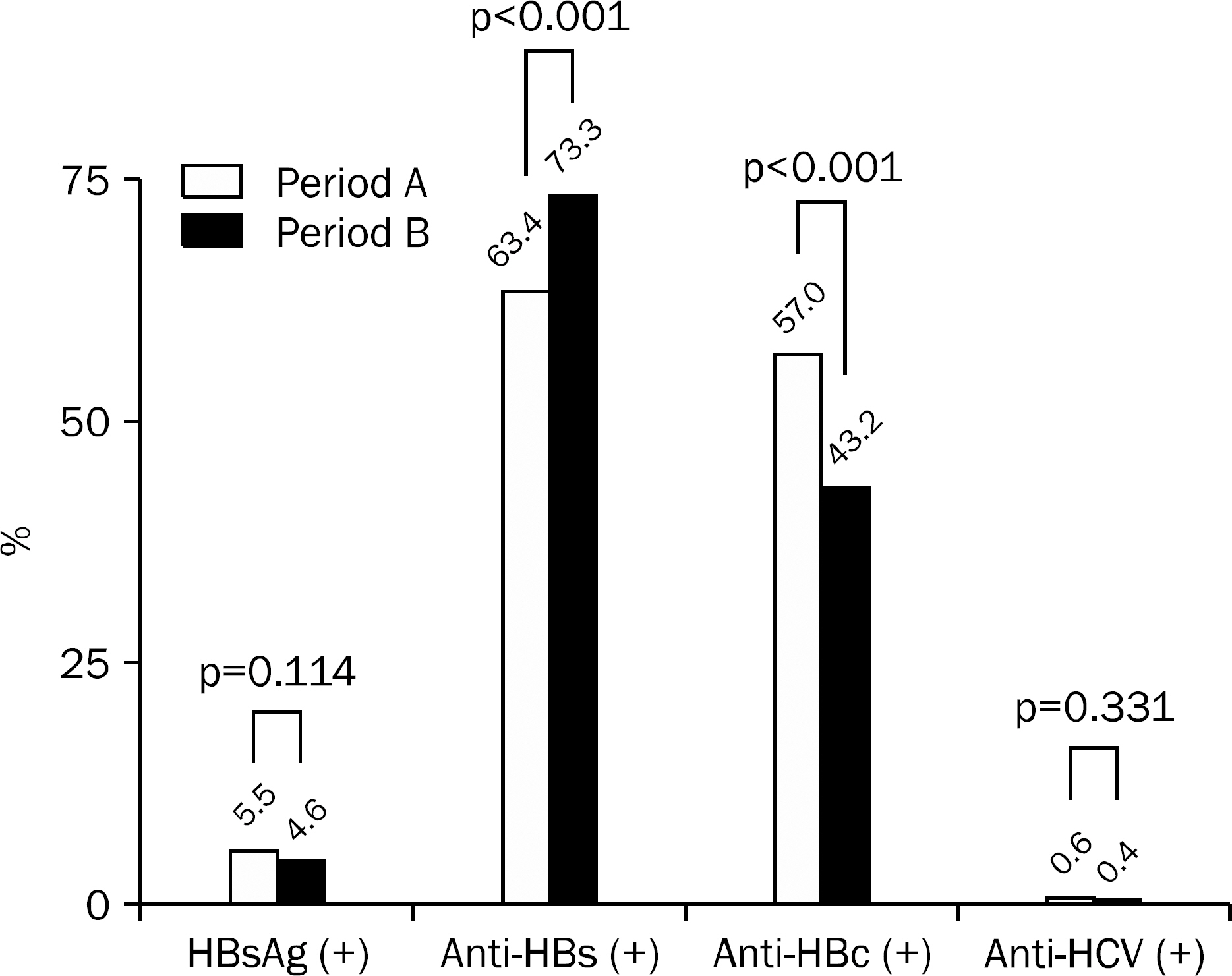Korean J Gastroenterol.
2011 Aug;58(2):82-87. 10.4166/kjg.2011.58.2.82.
Shifting in Seroprevalence of HBsAg and Anti-HCV during Recent 10 Years in Adults Resident in Daegu and Gyeongbuk Province
- Affiliations
-
- 1Department of Internal Medicine, Keimyung University College of Medicine, Daegu, Korea. nae99@dsmc.or.kr
- KMID: 1718414
- DOI: http://doi.org/10.4166/kjg.2011.58.2.82
Abstract
- BACKGROUND/AIMS
There have been only few studies on the population-adjusted seroprevalence of HBV and HCV and on the change of them for more than 10 years in Korea. Therefore, this study was performed to evaluate them at a single health center in Daegu and Gyeongbuk province considering the population composition ratio.
METHODS
We analyzed the seromarkers of HBV and HCV of 6,237 randomly sampled adults who had received health screening at the health promotion center in Dongsan hospital during the periods from year 1997 to 1999 (Period A) and from 2007 to 2009 (Period B).
RESULTS
The seroprevalences of HBsAg, anti-HBs, anti-HBc and anti-HCV were 4.8%, 70.2%, 47.4%, and 0.5%, respectively. There is no difference in the seroprevalence of HBsAg between period A and B. However, downward tendency of prevalence through A to B from 6.8% to 4.5% could be found in 40s, and upward tendency from 4.7% to 6.8% in 50s. As for the seroprevalence of anti-HCV, although there was no difference through A to B, for 50s, it decreasd from 2.0% to 0.3% (p=0.007). However, for 60s, it increased as much as decreasd for 50s.
CONCLUSIONS
The seroprevalence of HBsAg in Daegu/Gyeongbuk province was 4.8% and showed no difference through the time period of 10 years. The seroprevalence of anti-HCV was 0.5% and also showed no difference through the time periods.
MeSH Terms
Figure
Cited by 1 articles
-
Nonimmunity against hepatitis B virus infection in patients newly diagnosed with inflammatory bowel disease
Seong Jae Yeo, Hyun Seok Lee, Byung Ik Jang, Eun Soo Kim, Seong Woo Jeon, Sung Kook Kim, Kyeong Ok Kim, Yoo Jin Lee, Hyun Jik Lee, Kyung Sik Park, Yun Jin Jung, Eun Young Kim, Chang Heon Yang,
Intest Res. 2018;16(3):400-408. doi: 10.5217/ir.2018.16.3.400.
Reference
-
References
1. Marcellin P. Hepatitis B and hepatitis C in 2009. Liver Int. 2009; 29(Suppl 1):1–8.
Article2. Kim YS, Um SH, Ryu HS, et al. The prognosis of liver cirrhosis in recent years in Korea. J Korean Med Sci. 2003; 18:833–841.
Article3. Lee HS, Han CJ, Kim CY. Predominant etiologic association of hepatitis C virus with hepatocellular carcinoma compared with hepatitis B virus in elderly patients in a hepatitis B-endemic area. Cancer. 1993; 72:2564–2567.
Article4. Wasley A, Kruszon-Moran D, Kuhnert W, et al. The prevalence of hepatitis B virus infection in the United States in the era of vaccination. J Infect Dis. 2010; 202:192–201.
Article5. Chae HB, Kim JH, Kim JK, Yim HJ. Current status of liver diseases in Korea: hepatitis B. Korean J Hepatol. 2009; 15(Suppl 6):S13–S24.
Article6. Choe BH. The epidemiology and present status of chronic hepatitis B in Korean children. Korean J Pediatr. 2008; 51:696–703.
Article7. Kim SB, Lee WK, Choi H, et al. A study on viral hepatitis markers and abnormal liver function test in adults living in northwest area of Chungnam. Korean J Gastroenterol. 2009; 53:355–360.
Article8. Park KS, Lee YS, Lee SG, et al. A study on markers of viral hepatitis in adults living in Daegu and Gyungbuk area. Korean J Gastroenterol. 2003; 41:473–479.9. Joo KR, Bang SJ, Song BC, et al. Hepatitis B viral markers of Korean adults in the late 1990s : survey data of 70,347 health screenees. Korean J Gastroenterol. 1999; 33:642–652.10. Lim YS. Current status of liver disease in Korea: hepatitis C. Korean J Hepatol. 2009; 15(Suppl 6):S25–S28.
Article11. Shin HR, Kim JY, Song JB, et al. Seroepidemiologic study of hepatitis B virus(HBV) and hepatitis C virus(HCV) infection among Koreans in rural area, Korea. Korean J Prev Med. 1997; 30:17–30.12. Jang KM, Woo SH, Yun DH, et al. Seroepidemiologic survey on type B viral hepatitis in Incheon area. Korean J Med. 1983; 26:1331–1336.13. Jeong S, Yim HW, Bae SH, Lee WC. Changes of hepatitis B surface antigen seroprevalence in Korea, 1998–2005. Korean J Epidemiol. 2008; 30:119–127.
Article14. Jun GH, Kim JJ, Shin DH, Yoon SD. A survey of HBs antigenemia among healthy primary and middle children, pregnant women in Kyungpook Province. J Korean Pediatr Soc. 1983; 26:1188–1195.15. Seo JH. Hepatitis B surface antigen and antibody positive rates of children and adolescents in Jeju. Korean J Hepatol. 2003; 9:304–314.16. Lee DH, Kim JH, Nam JJ, Kim HR, Shin HR. Epidemiological findings of hepatitis B infection based on 1998 National Health and Nutrition Survey in Korea. J Korean Med Sci. 2002; 17:457–462.
Article17. Esteban JI, Sauleda S, Quer J. The changing epidemiology of hepatitis C virus infection in Europe. J Hepatol. 2008; 48:148–162.
Article18. Shin HR, Hwang SY, Nam CM. The prevalence of hepatitis C virus infection in Korea: pooled analysis. J Korean Med Sci. 2005; 20:985–988.
Article19. Suh DJ, Jeong SH. Current status of hepatitis C virus infection in Korea. Intervirology. 2006; 49:70–75.
Article20. Shin HR. Epidemiology of hepatitis C virus in Korea. Intervirology. 2006; 49:18–22.
Article
- Full Text Links
- Actions
-
Cited
- CITED
-
- Close
- Share
- Similar articles
-
- Prevalence of HBsAg and anti-HCV Among Korean Blood Donors
- Geographic Characteristics of Positivity of Anti - HCV and Chonnam Province: Survey Data of 6, 790Health Screenees
- Seroprevalence Study of Hepatitis C in Leprosy Patients
- A Study on positive rate of HBs Ag, HBs Ab and anti-HCV in Korean adults
- Seroprevalence of antibody to the hepatitis C virus in methamphetamine abusers





